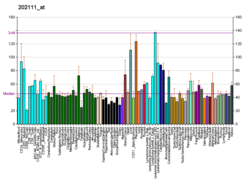Structure
The cryo electron microsopic studies revealed that human AE2 protein forms a homodimer and stays in resting state of inward-facing conformation at physiological pH.[13] A loop between transmembrane (TM) helices 10 and 11 extends from TM domain into its cytoplamic domain, forming a "trigger" locking the TM helices in the resting state. In addition, the C-terminal loop (CTD loop) inserts into the anion binding pocket to further block its activities.
Mechanism of ion exchange
During the process of acid secretion, the cellular pH increases, triggering the release of the "trigger" loop from the cytoplasmic domain.[14] This allows for the re-arrangement of the TM helices, while the CTD loop is forced out, enabling HCO3- binding. Further conformational changes then turn the AE2 protein into an outward-facing conformation, releasing HCO3- into the extracellular environment and capturing Cl- into the binding pocket. Finally, the AE2 protein returns to its inward-facing conformation and releases Cl- into the cytosol. This working cycle of the AE2 protein replaces a weak acid anion with a strong acid anion, thereby lowering the cellular pH and re-balancing pH homeostasis.
See also
References
Further reading




